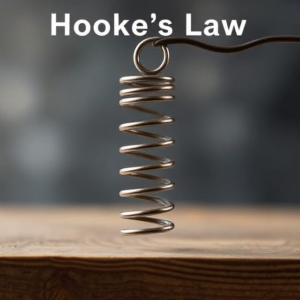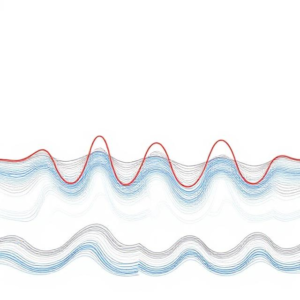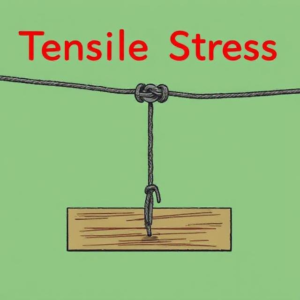Hooke’s Law Explained Simply
Imagine you have a spring. When you pull or compress the spring, it stretches or shrinks. Hooke’s Law helps explain exactly how the spring reacts to that force.
What is Hooke’s Law?
Hooke’s Law is a principle in physics that states that the force required to stretch or compress a spring is directly proportional to the displacement (how much the spring is stretched or compressed).
In simple words:
- The more you pull or compress the spring, the more force you need.
- The force needed to stretch or compress the spring is directly related to how far you stretch or compress it.

The Formula for Hooke’s Law
The formula for Hooke’s Law is:
Where:
- F = The force applied to the spring (measured in Newtons, N)
- k = The spring constant (measured in N/m), which tells you how stiff the spring is
- x = The displacement (how far the spring is stretched or compressed from its equilibrium position, measured in meters, m)
Explanation of the Terms
- Force (F): This is the force you apply to stretch or compress the spring. It’s measured in Newtons (N).
- Spring Constant (k): This is a measure of how stiff or rigid the spring is. A higher value of k means the spring is stiffer, so it requires more force to stretch it by the same amount. A lower value of k means the spring is more flexible.
- Displacement (x): This is how much you stretch or compress the spring from its natural position (its equilibrium length). If you pull the spring, this value is positive. If you compress it, it’s negative.
Key Points to Remember About Hooke’s Law:
- Proportional Relationship: The force you apply is proportional to how much the spring stretches or compresses. If you double the stretch, you double the force.
- Elastic Limit: Hooke’s Law only holds true as long as the spring is within its elastic limit. If you stretch or compress the spring too much, it can be permanently deformed, and the relationship no longer holds.
- Restoring Force: When you stretch or compress a spring, it wants to return to its natural position. The force you apply is always resisted by an equal and opposite restoring force from the spring, which pushes it back to its original shape.
Example to Understand Hooke’s Law:
Let’s say you have a spring with a spring constant (k) of 10 N/m, and you pull it to stretch it by 0.5 meters (this is your displacement, x).
Using Hooke’s Law:
So, the force required to stretch the spring by 0.5 meters is 5 Newtons.
If you wanted to stretch it by 1 meter, you would need 10 Newtons of force, because the force is proportional to the displacement.
Real-World Example of Hooke’s Law: A Spring
- A Spring in a Toy: Imagine a toy car that uses a spring to launch forward. The spring gets compressed when you push it, storing potential energy. The force required to compress the spring depends on the spring constant. If the spring constant is high (stiff spring), it takes more force to compress it.
- A Bungee Cord: A bungee cord also follows Hooke’s Law. The more you stretch the cord, the greater the force it exerts to pull you back.
Why Does Hooke’s Law Matter?
Hooke’s Law is important because it helps engineers and scientists understand how objects like springs, rubber bands, and even materials like metals respond to forces. It’s used in many areas:
- Engineering: Designing springs in machines, watches, cars, and other devices.
- Physics: Understanding the behavior of materials and forces.
- Medical Devices: Springs are used in medical tools, such as stents or prosthetics.
Summary:
- Hooke’s Law explains that the force needed to stretch or compress a spring is directly proportional to how much you stretch or compress it.
- The formula is:
Where:
- F = Force applied to the spring
- k = Spring constant (how stiff the spring is)
- x = Displacement (how much the spring stretches or compresses)
- It only works if the spring hasn’t been stretched beyond its elastic limit.
- Applications: Hooke’s Law helps in designing springs, understanding materials, and creating various mechanical devices.
This law is key to understanding how things like springs, rubber bands, and other elastic materials work when forces are applied to them.











